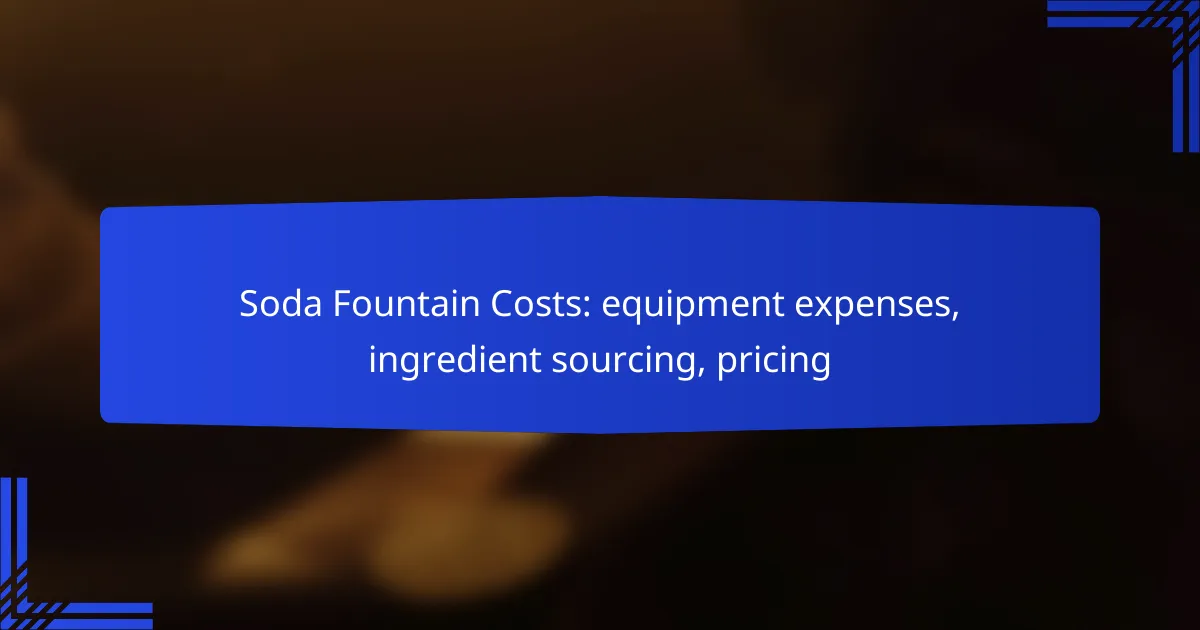Starting a soda fountain business involves understanding various costs, including equipment expenses, ingredient sourcing, and pricing strategies. Initial investments for equipment can reach several thousand Australian dollars, while sourcing high-quality ingredients from reliable suppliers is crucial for success. Additionally, exploring different pricing models can help businesses maximize profitability and attract customers.
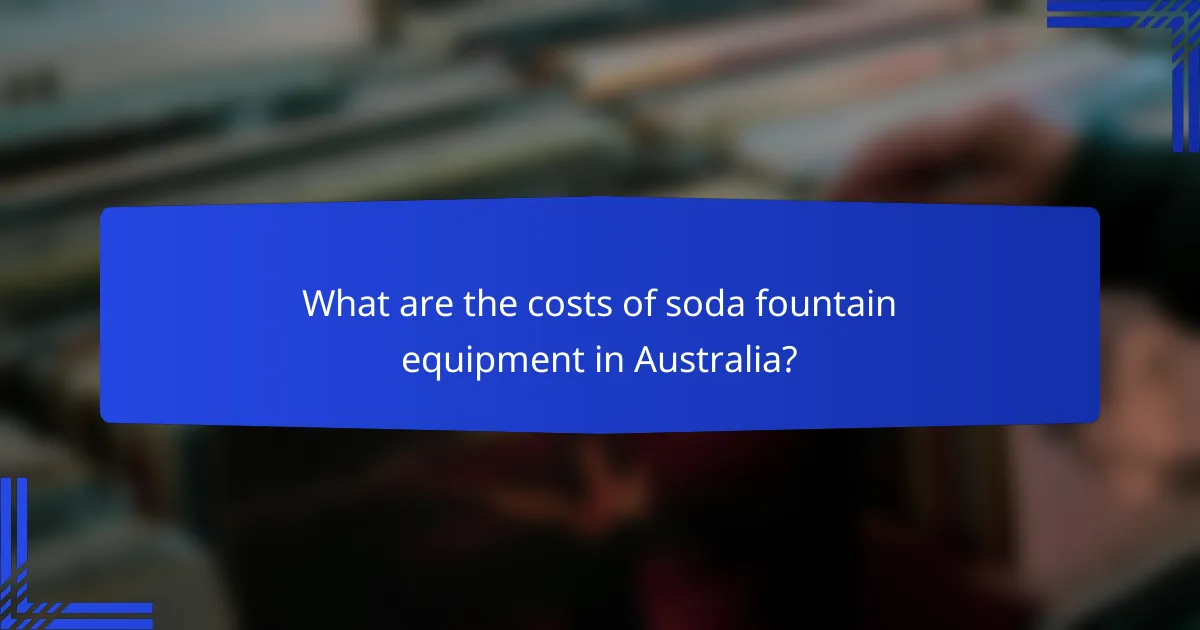
What are the costs of soda fountain equipment in Australia?
The costs of soda fountain equipment in Australia can vary significantly based on the type of machine, installation needs, and ongoing maintenance. Generally, businesses should expect to invest several thousand Australian dollars for a complete setup, including the machine and necessary components.
Commercial soda fountain machines
Commercial soda fountain machines typically range from AUD 3,000 to AUD 10,000, depending on the brand, features, and capacity. Higher-end models may offer advanced functionalities like touchscreens and multiple flavor options, which can enhance customer experience but also increase initial costs.
When selecting a machine, consider factors such as the expected volume of sales and the variety of beverages to be offered. It’s essential to balance upfront costs with potential long-term savings in ingredient usage and maintenance efficiency.
Installation expenses
Installation expenses for soda fountain equipment can range from AUD 500 to AUD 2,000, depending on the complexity of the setup and any necessary plumbing or electrical work. It’s advisable to hire professionals familiar with commercial installations to ensure compliance with local regulations and safety standards.
Before installation, assess the site to determine any modifications needed for optimal machine placement. This can help avoid unexpected costs and delays during the installation process.
Maintenance costs
Ongoing maintenance costs for soda fountain equipment typically fall between AUD 200 and AUD 800 annually. Regular maintenance is crucial to ensure the machine operates efficiently and to prolong its lifespan. This includes routine cleaning, checking for leaks, and replacing worn-out parts.
Consider establishing a maintenance contract with a service provider to manage these costs effectively. This can help prevent larger, unexpected expenses due to equipment failure or neglect.
Brand comparisons
When comparing brands of soda fountain machines, it’s important to evaluate factors such as reliability, customer service, and warranty options. Popular brands like Coca-Cola Freestyle and Pepsi Spire offer different features and pricing structures, which can influence your decision based on your business needs.
Research customer reviews and seek recommendations from other businesses to gauge performance and support. A well-informed choice can lead to better long-term satisfaction and operational efficiency.
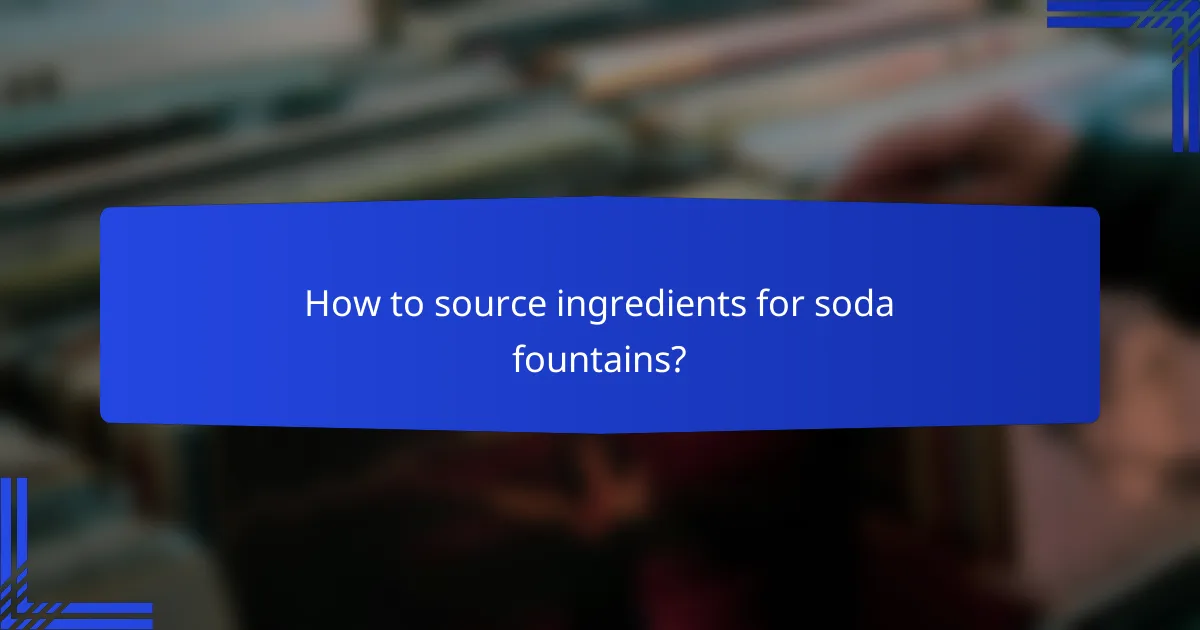
How to source ingredients for soda fountains?
Sourcing ingredients for soda fountains involves finding reliable suppliers who can provide high-quality syrups, carbonated water, and other necessary components. Consider local options, bulk purchasing, and ingredient quality to ensure a successful operation.
Local suppliers in Australia
In Australia, local suppliers can provide fresh ingredients that meet regional taste preferences. Look for distributors who specialize in beverage ingredients, as they often offer a range of syrups and mixers tailored for soda fountains.
Some well-known suppliers include companies like Coca-Cola Amatil and Schweppes Australia, which have established networks for sourcing and distributing soda fountain ingredients across the country.
Bulk purchasing options
Purchasing ingredients in bulk can significantly reduce costs for soda fountain operations. Many suppliers offer discounts for larger orders, which can lead to savings of up to 20-30% compared to buying smaller quantities.
Consider joining a buying group or cooperative to leverage collective purchasing power, allowing you to access better pricing and terms from suppliers.
Ingredient quality considerations
Quality is crucial when sourcing ingredients for soda fountains, as it directly impacts flavor and customer satisfaction. Look for suppliers that provide high-quality syrups made from natural ingredients without artificial additives.
Conduct taste tests and request samples before committing to larger orders. This ensures that the flavors align with your brand and meet customer expectations.
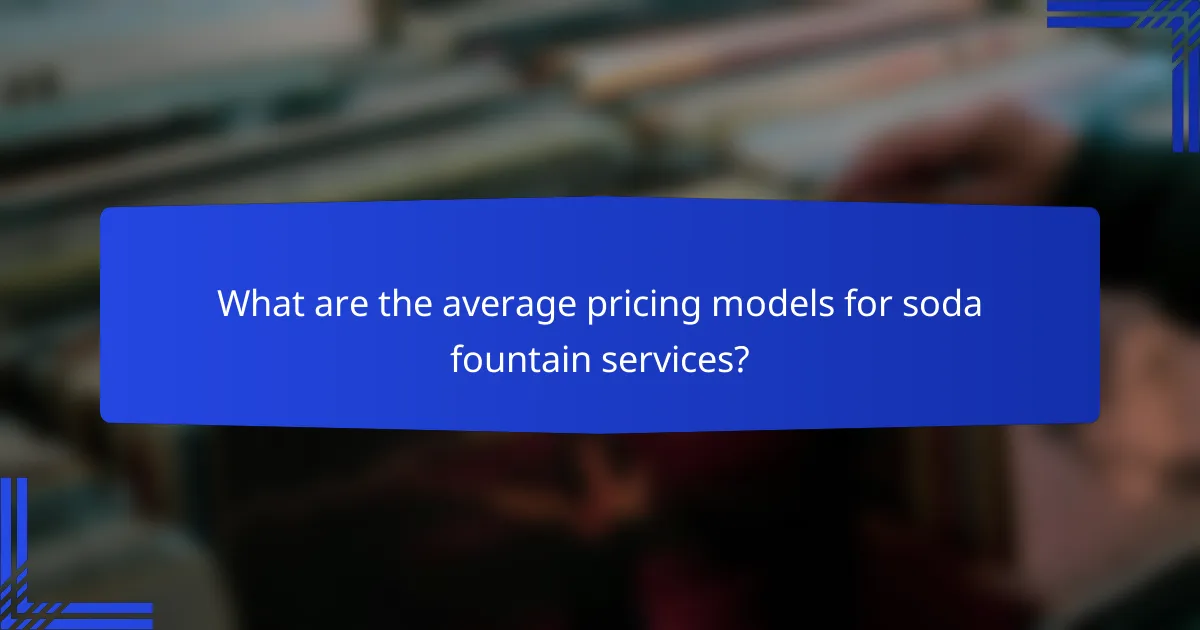
What are the average pricing models for soda fountain services?
The average pricing models for soda fountain services typically include per-serving pricing, subscription options, and seasonal strategies. Understanding these models helps businesses determine the most cost-effective approach to offering soda fountain beverages.
Pricing per serving
Pricing per serving is a straightforward model where customers pay for each drink they order. This can range from about $0.50 to $2.00 per serving, depending on the type of beverage and location. Factors influencing this price include ingredient quality, local market conditions, and overhead costs.
Businesses should consider portion sizes and ingredient costs when setting prices. Offering combo deals or discounts for larger servings can attract more customers and increase sales volume.
Subscription models
Subscription models allow customers to pay a flat fee for unlimited access to soda fountain drinks over a specified period, such as monthly or annually. Prices for these subscriptions can range from $10 to $50 per month, depending on the offerings and frequency of use.
This model can enhance customer loyalty and ensure steady revenue. However, businesses must carefully calculate the average consumption to avoid losses from overuse. Offering tiered subscriptions based on consumption levels can help manage costs effectively.
Seasonal pricing strategies
Seasonal pricing strategies involve adjusting prices based on demand fluctuations throughout the year. For instance, prices may increase during summer months when soda consumption typically rises, while offering discounts in the off-season can help maintain sales.
Businesses should analyze sales data to identify peak seasons and adjust their pricing accordingly. Promotions tied to holidays or local events can also boost sales during slower periods, making it essential to stay flexible and responsive to market trends.
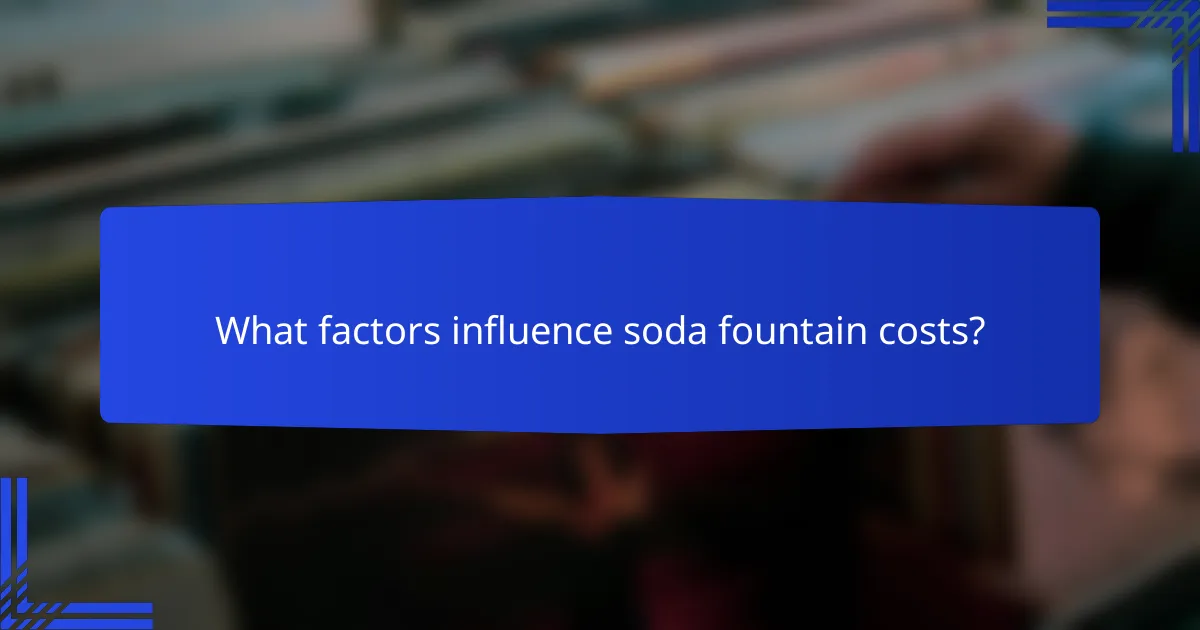
What factors influence soda fountain costs?
Soda fountain costs are influenced by various factors including location, sales volume, and market competition. Understanding these elements can help businesses optimize their expenses and pricing strategies.
Location-based pricing
The cost of operating a soda fountain can vary significantly based on its location. Urban areas typically have higher overhead costs such as rent and utilities, which can lead to increased prices for consumers. In contrast, rural locations may benefit from lower costs but might face challenges in attracting a sufficient customer base.
Additionally, local regulations and taxes can impact pricing. For example, some regions impose higher sales taxes on sugary beverages, which can affect the final price consumers pay.
Volume of sales
The volume of sales directly affects the overall cost structure of a soda fountain operation. Higher sales volumes can lead to economies of scale, allowing businesses to purchase ingredients and supplies at lower prices. Conversely, lower sales volumes may result in higher per-unit costs, making it challenging to maintain profitability.
Establishing a pricing strategy that reflects the expected sales volume is crucial. For instance, offering discounts for bulk purchases can incentivize higher sales, while maintaining competitive pricing can attract more customers.
Market competition
Market competition plays a significant role in determining soda fountain costs. In areas with multiple competitors, businesses may need to adjust their prices to remain attractive to consumers. This can lead to price wars, which may erode profit margins if not managed carefully.
To navigate competitive pressures, businesses should conduct regular market analyses to understand pricing trends and consumer preferences. Offering unique flavors or premium ingredients can also differentiate a soda fountain from competitors, potentially allowing for higher pricing without losing customers.
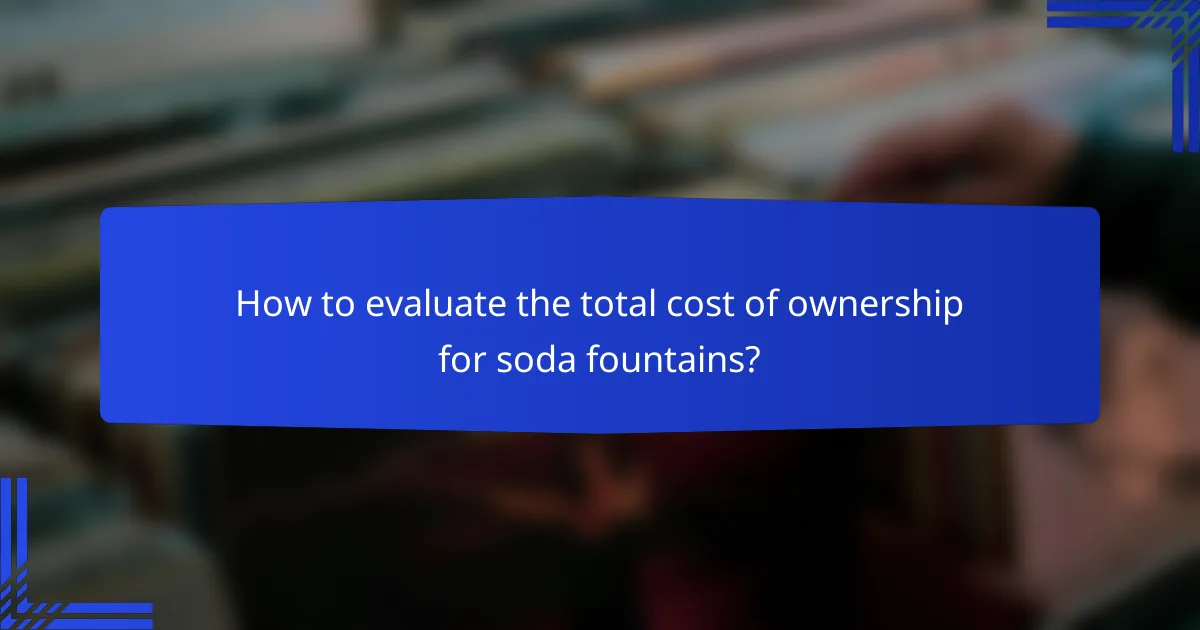
How to evaluate the total cost of ownership for soda fountains?
Evaluating the total cost of ownership for soda fountains involves assessing both initial investment and ongoing expenses. This comprehensive analysis helps determine the financial viability and long-term profitability of the equipment.
Initial investment vs. long-term costs
The initial investment for a soda fountain typically includes the purchase price of the machine, installation fees, and any necessary plumbing or electrical work. Depending on the model and features, the upfront cost can range from a few hundred to several thousand dollars.
Long-term costs encompass ingredient sourcing, maintenance, and operational expenses. Ingredients like syrup and carbonated water can vary in price, often influenced by supplier contracts and market conditions. Regular maintenance is essential to ensure optimal performance and can incur additional costs over time.
Return on investment analysis
To analyze the return on investment (ROI) for a soda fountain, calculate the expected revenue generated from beverage sales against the total costs incurred. A well-placed soda fountain can yield significant profits, especially in high-traffic areas.
Consider factors such as sales volume, pricing strategies, and customer preferences. A simple formula for ROI is: (Net Profit / Total Investment) x 100. Aim for an ROI of at least 20-30% to ensure the investment is worthwhile. Regularly review sales data to adjust strategies and maximize profitability.
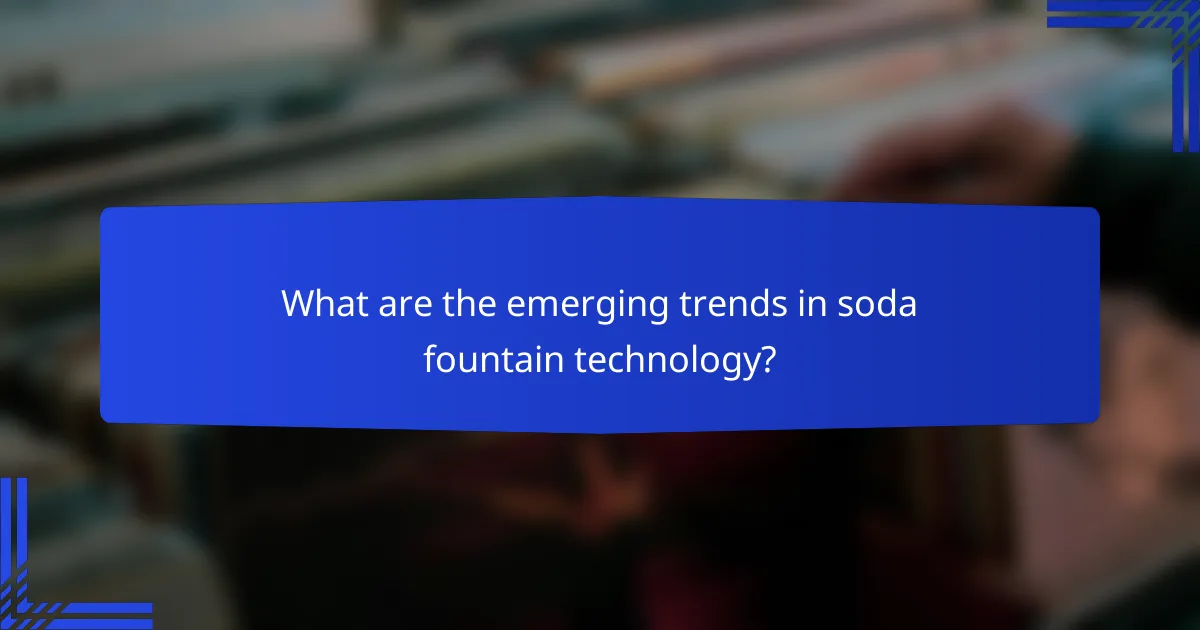
What are the emerging trends in soda fountain technology?
Emerging trends in soda fountain technology focus on enhancing user experience and sustainability. Innovations such as smart soda fountains and sustainable ingredient sourcing are reshaping how businesses operate and meet consumer demands.
Smart soda fountains
Smart soda fountains utilize advanced technology to improve efficiency and customer interaction. These systems often feature touchscreens for easy navigation, allowing users to customize their drinks with various flavors and carbonation levels.
Additionally, smart fountains can track inventory and usage patterns, helping operators manage supplies more effectively. This data-driven approach can reduce waste and optimize ingredient sourcing, ultimately lowering operational costs.
Sustainability in ingredient sourcing
Sustainability in ingredient sourcing is becoming increasingly important for soda fountain operators. Businesses are now prioritizing local and organic ingredients, which can enhance flavor while reducing carbon footprints associated with transportation.
Choosing suppliers who adhere to sustainable practices not only supports environmental goals but can also attract eco-conscious consumers. Operators should consider establishing partnerships with local farms or distributors to ensure a steady supply of high-quality, sustainable ingredients.
